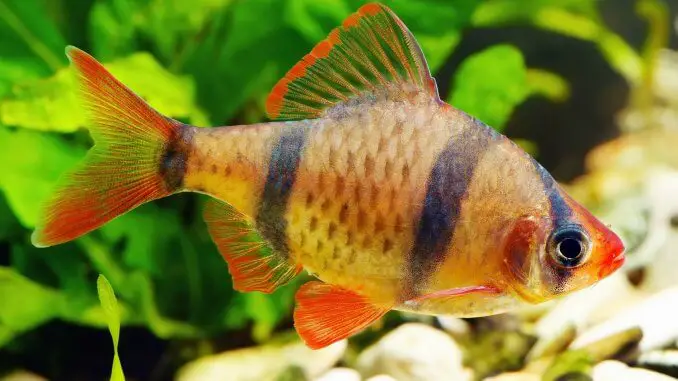
With personalities just as colorful as their scales, tiger barbs are delightful little fish to have in your aquarium. It’s easy to see why they are so popular and well-loved.
They come in a variety of color forms, love to play and show off, and like all barb fish, are easy to care for.
Though they have a bit of a reputation as nuisance “fin-nippers”, these fish are not harmful and will do just fine in the right tank.
You can be sure that a group of tiger barbs will leave just the right impression on your tropical freshwater aquarium. Read on to learn how to care for them and how to make make your aquatic environment just right for them.
TABLE OF CONTENTS
Tiger Barbs Facts & Overview
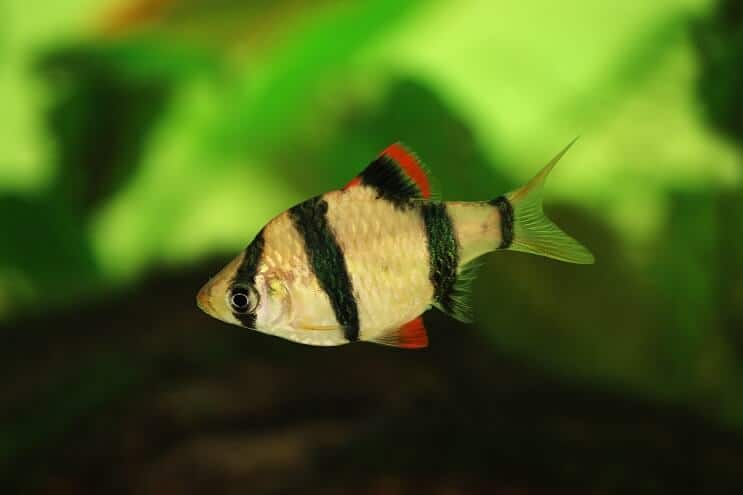
| Category | Rating |
| Care Level: | Easy to moderate |
| Temperament: | Playful, but can be aggressive |
| Color: | Varies, but typically silver or gold with four black bands |
| Lifespan: | 5-7 years |
| Size: | 2-3 inches |
| Diet: | Omnivore |
| Family: | Cyprinidae |
| Minimum Tank Size: | 20 gallons |
| Tank Setup: | Fine gravel substrate with rocks at the bottom and submerged vegetation planted along the sides |
| Compatibility: | Often compatible |
The tiger barb is scientifically known as Puntigrus tetrazona but used to be referred to as Puntius tetrazona and Capoeta tetrazona. This species is a tropical freshwater fish from the Cyprinidae family, which includes Minnows, Carps and Chubs.
It is also known as the Sumatra Barb, as it is native to Sumatra and Borneo.
This fish is very popular within the aquarium hobby and this has led to wild populations spreading to Puerto Rico and the United States.
Their species name Tetrazona, refers to the 4-band pattern that distinguishes it from other Barbs with 5 or 6 bands.
Tiger Barbs are popular aquarium fish which can live for up to 7 years and can be found at just about any aquarium supplier.
You should expect to pay anywhere from $3 to $5 depending on size, quantity, and color. There are many varieties and colors due to the high rate of selective breeding and hybridization that occurs with this species.
Typical Behavior
The Tiger Barb has a bit of a reputation for being aggressive and dominant. While it’s true that they are very pushy and like to bump and bite at their tank mates, their behavior is more annoying than harmful.
These fish are very competitive and will form small hierarchies where they will compete for dominance. They are showy, active fish that like to be out in the open. You can watch them chase, bump, and nip at one another in the middle levels of your tank.
They must be kept in a school of at least 5 individuals, though they prefer no less than 8 and no more than 12. When kept in a group too small, they are more likely to harass other tank mates.
If they are kept alone or with only one other individual, they will become stressed, timid, and keep themselves hidden.
Appearance
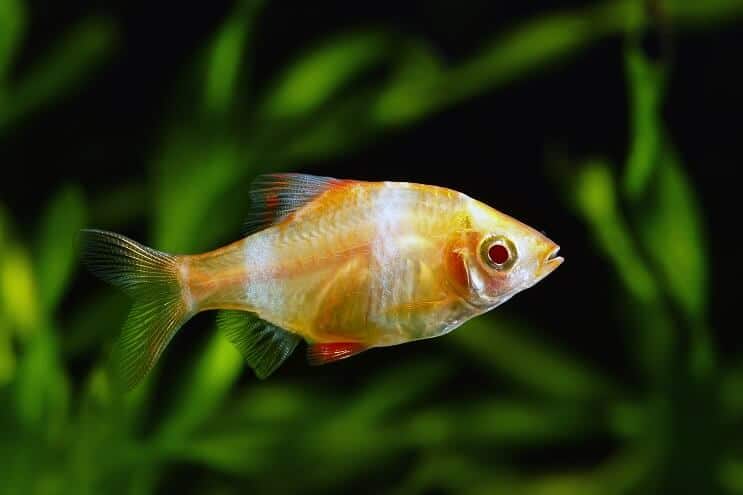
Tiger Barbs are quite small and only grow to around 2.5 inches long. They are shaped like barbs or spear points with pointed triangular snouts and wide flared bodies.
Females are slightly larger than males with rounder bodies and duller colors, while males are more streamlined and have more striking colors and patterns.
The colors and patterns on a typical Tiger Barb resemble the animal they are named after: golden yellow, with 4 large black bands and bright orange markings on the snout and fins. However these days many breeds and color forms exist. Their scales can be gold, red, pale silver or even green. They can have solid bands, broken bands or even no bands at all.
The colors can become more intense depending on the type of diet you are feeding them, males tend to be at their brightest when trying to attract a mate.
There is even an albino variant, with white bands and pale cream-colored skin.
Habitat and Tank Conditions

In their natural habitat on the Malay Peninsula, these fish are found in lakes, swamps, and small streams.
They are found at many different depths and bottom types, in high and low light. However, they tend to prefer shallow waters which are murky and acidic due to decaying plant material and algae.
As for water temperature it will generally be between 77-82°F, but they can withstand temperatures as low as 65°F.
Their ability to tolerate a wide range of parameters has allowed them to become invasive in subtropical waters.
Tank Setup
For your Barb tank, you should maintain tropical water temperatures between 75 and 82°F, with a pH between 6.0-8.0.
The substrate should be fine gravel, with large rocks and cobbles which can be used for shelter. Tiger Barbs live at many depths and light levels, so a basic aquarium hood light will be fine for them.
A low-flow or undergravel filter can mimic the small currents that Barbs experience in their natural habitats.
Submerged freshwater plants and algae provide shelter, breeding ground, and a supplemental food source. However, these fish like wide open space for swimming, so their tank should not be too densely planted.
Your plants should be placed at the sides and corners of the tank, leaving the center open for free swimming.
All plants should be able to grow to the middle levels of your tank. Java fern and water wisteria are both good choices, as they don’t need specialized lighting and are compatible with both Tiger Barbs and their ideal tank mates.
Dwarf hairgrass is an especially good choice for lining the substrate of a breeding tank.
Your Barbs will appreciate floating driftwood and bogwood for extra covering; just be aware that when this material decays, it can lower your tank’s pH level.
These are active and mischievous fish that may try to jump out of their tank, so an aquarium hood is absolutely needed.
What Size Aquarium Do They Need?
These are very active fish that need plenty of room to swim and play. Tiger Barbs need at least a 20-gallon tank – this would be suitable for up to 5 of them.
For each additional Tiger Barb added, make sure to add 3 gallons.
So 8 Tiger Barbs would need at least a 29-gallon tank.
Tank Mates
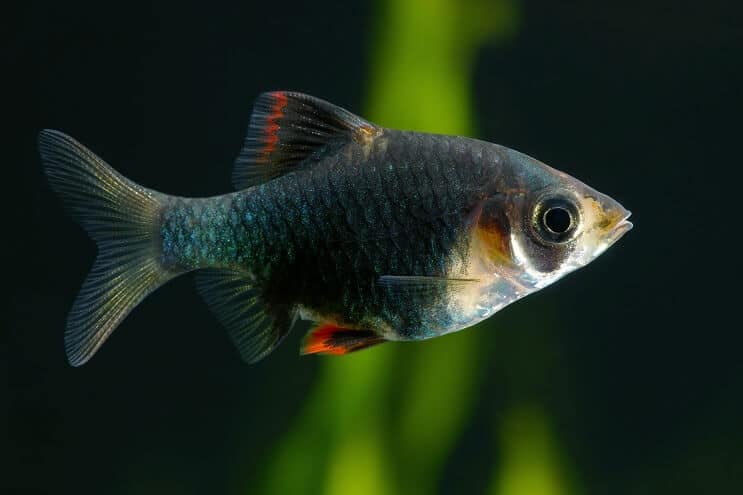
Tiger Barbs have expanded far outside of their native habitat, so even in the wild now they co-habitate with many different freshwater species.
Five-banded Barbs and six-banded Barbs are known to have the same native habitat, so these Barbs make some of the best tank mates.
Other good Barbs for your tiger tank include Rosy Barbs, Cherry Barbs, and Tinfoil Barbs.
Outside of other Barbs, they should be kept with similar-sized species that are fast-moving, with short fins that the Barbs cannot nip and bite at.
Clown Loaches are one of the most ideal companions for these fish. They can also be safely kept with Plecos, Tetras, and small catfish such as Corydoras and pictus.
You can also keep them with gouramis, but this is at a risk because of the gouramis’ longer fins.
It is not recommended to keep them with small invertebrates, as these pushy fish are likely to harass them. However, they pose no real risk to a snail or two.
Angelfish, bettas, and any other long-finned fish should be avoided as barbs will demonstrate their reputation as fin-nippers. While this nipping cannot harm the fish, it may cause them stress.
Tiger Barbs are less likely to be aggressive with their tank mates if they are not the first ones in the tank. You should add them to a pre-established tank, rather than adding new fish to a Tiger Barb tank. If they are the first in the tank, the Barbs will see the new fish as intruders upon their territory.
Keeping Tiger Barbs Together
A lonely Barb is not a happy Barb! When kept alone or even with only one other Barb, this fish will become timid and skittish.
In a group of less than 8, Barbs will behave aggressively with the other fish in your tank. They are at their best in groups of 8 to 12, and they are extremely playful and social with each another.
Diet
In the wild, these fish feed on algae, plant material, zooplankton, worms, and other small invertebrates.
The water in your tank is not nearly as biodiverse as the waters of a wild lake or stream, so it can be a little difficult to replicate the diet of a zooplankton feeder.
Water fleas, larval and adult brine shrimp work well (larval brine shrimp is especially important for newly-hatched Barbs). In addition to live invertebrates, they should be given freeze-dried bloodworms and quick-sinking crushed-flake or pellet foods.
Tiger Barbs need a varied diet in order to stay healthy and show their beautiful colors more vividly – they should be given lots of greenery.
Your Barbs will feed on the algae that grows alongside your plants, but you can also supplement their diets with cooked garden vegetables from the store. They love boiled lettuce, zucchini and cucumber. These vegetables are packed full of nutrients that make for very healthy fish!
They are big eaters and should be fed twice a day, every day. All pellet and flake foods should be eaten in 3 minutes or less.
Care
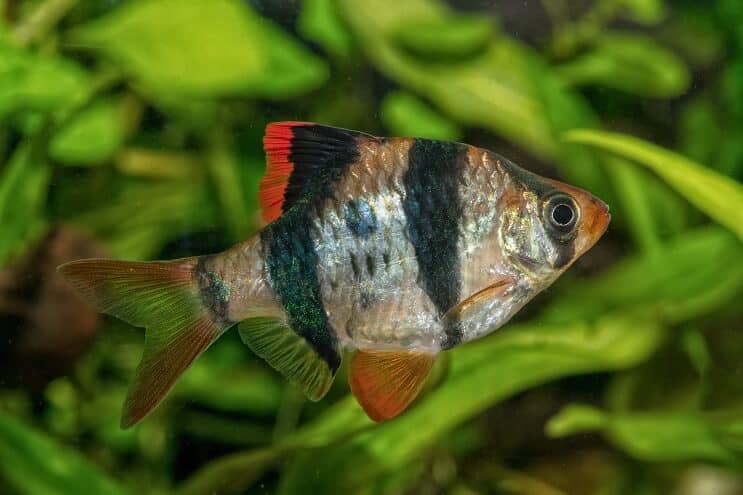
Like many aquarium fish, Tiger Barbs are susceptible to ich. Fish with Ich will have a sprinkling of white dots on their scales and fins.
It is caused by poor tank maintenance and poor water quality – the good news is that it is treatable. Affected fish should be quickly isolated.
To reduce the risk of ich and other diseases, you should check the water quality at least once a week and clean the tank at least once a month. More densely populated tanks need to be cleaned more often.
Poor diet is another major cause of illness. These feeders require a little bit of everything, from live prey to pellets to plant material. You can mix their diet up by alternating between commercial fish food and specialty food such as bloodworms and cooked garden veggies every few days.
Keep a close eye on the interactions between your Barbs and their tank mates. You should watch for signs of distress in more peaceful tank mates and those that are more frequently harassed.
Signs of stress-related illness include sudden behavior changes, erratic or neurotic behavior, decreased activity and appetite, paleness and discoloration and increased hiding.
Breeding
Tiger Barbs are temporarily-paired spawners, meaning that they will choose a different mate for each spawning. They spawn multiple times throughout their lives and reach maturity at 6-7 weeks of age.
They spawn in the substrate under the cover of submerged vegetation, and can produce anywhere from 500 to 700 eggs per spawning.
If you plan to breed, you should condition the sexes separately before pairing them off. During conditioning, your Barbs must be fed up to 3 times a day and provided with adult brine shrimp and freeze-dried bloodworms.
Male Barbs that have entered breeding condition will display more intense colors, and females will become larger and rounder. Once ready, the two sexes can be placed together to pair off.
Single pairs can be placed in a breeding tank with thick underwater reeds and grasses, along with medium-sized cobbles or marbles to spawn on.
The eggs will stick to the weeds and substrate, and must be removed once deposited to prevent egg cannibalism.
They will hatch in about 48 hours and retain their yolk sacs for the next 3 to 5 days. Once the yolk sac is lost, the larvae must be fed larval brine shrimp for the next 2 or 3 days, before moving to commercial fry food and eventually microworms.
Are Tiger Barbs Suitable For Your Aquarium?
With their eye-catching colors, black stripes and playful personalities, these little fish will certainly burn bright in your aquarium.
They are social, playful, fun to watch and make beautiful additions to a tropical tank.
Those who take them on should be willing to reign in their fin-nipping, and keep their diets balanced and nutritious.
Keepers with a bit of experience with tropical freshwater fish should find their care to be a very rewarding task. They are relatively low-maintenance compared to other species and aren’t difficult to keep even – for beginners!
Do you have any questions about these great starter tropical freshwater fish? Let us know in the comments section below…

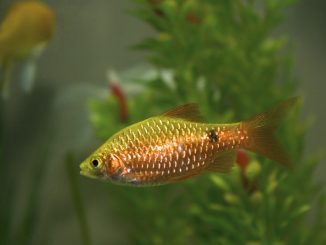



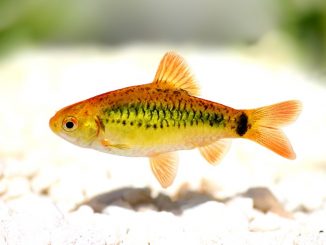

Hi there. I’d really love to add barbs to my 45 gl tank. I have 2 questions though. If I get a school of mixed barbs would they acknowledge each other as kindred spirits? For example green tiger barbs with striped tiger barbs. Also, I’m concerned my water is hard for them. My test maxed at 180 ppm. Any advice to give a newbie?
Tiger barbs are a very entertaining species. As mentioned in the article, they are better as a school of more than 4-5. I’ve had up to 15. The best part of keeping them in a large school is that they mess with each other and won’t bother the other fish in the tank. They are very easy to maintain, and eat anything that you would feed the other tank mates. They love to race around the tank a few times a day. The most interesting thing about them is when they sleep, they point downward. Very cool specimen for even a beginner.
I am a new aquarium owner. I have a 30 gallon tank that I set up a week before I purchased my fish. I went to the pet store and came home with two tiger barbs, to Blackmore And a beta. Today I noticed the tiger barbs nipping at the Black moors. My question is will I have to separate them? I would have thought the fish expert would have told me that they would not be able to live together.